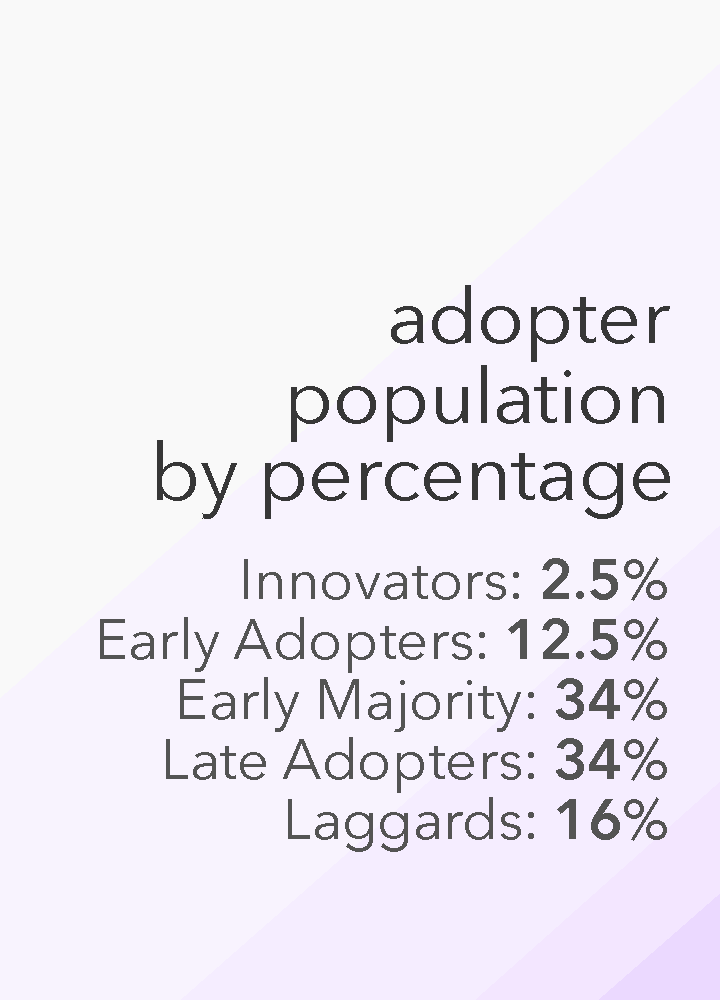
Understanding Adopters
Influential social theory says getting people to buy into innovation means understanding who they are and what motivates them to change.
Implementing a new idea, behavior, or technology is a multi-stage process with several moving parts. It doesn’t matter whether the innovation is on a personal, professional, or societal level, if it involves winning over a group of people in order to make it a success, it takes time, energy, and most importantly, adoption from the majority.
When a company makes the decision to implement any kind of innovation, such as technology, it is critical to have an implementation strategy. Simply dropping a technology solution on the staff and workforce without adequate explanation or training is like dropping the monetary value of said innovation out the window. Implementation strategies begin with an in-depth understanding of the people who must adopt the innovation, their interests and concerns, and the types of communication channels to which they best respond.
Of course, not all innovations are created equal. Social media, for instance, spread quickly and was adopted in just a few years. Other technologies, like solar power, have spread slowly and may take decades for long-term adoption. This begs the question: How do successful ideas spread?
Everett Rogers wrote one of the most influential social science books of all time, called Diffusion of Innovations. In it, he discusses the way new ideas and technology spread throughout a society by describing five types of adopters—innovators, early adopters, early majority, late majority, and laggards.
According to Rogers’ theory, the level of adoption rises over time, moving slowly at first, then rising quickly, and finally, the last levels of adoption take a long time to achieve. These steps occur over five stages of adoption:
- Knowledge of an idea, practice, or technology (the innovation), which is perceived as new.
- Persuasion from external sources through different communication channels.
- The decision to reject or adopt the innovation.
- Implementation of the innovation (if there is a decision to adopt).
- Confirmation that the adopter will continue to make use of the innovation.
When he published in 1962, Rogers was quickly acknowledged as having revolutionized communications theory and technology adoption studies because he rejected throwing innovation blindly to the masses. Instead, he identified five types of “adopters” of new technology and suggested targeting each type with different, tailored communication channels.

The first adopters – the innovators – are a small but important group. They are seen as outsiders or “geeks” who want novelty and have little influence over the masses, but they are also risk-takers, adventurous, and demand the cutting edge. This group offers a first test of a new idea and are more tolerant of failures. They provide grounds for revision and help build momentum around the idea. Most importantly, they introduce new ideas to the larger population because they are eager to share with their friends and communities. These are enthusiasts who want a breakthrough.
Early adopters are a small, forward-thinking group that is highly influential because they are far more socially connected and respected than innovators. They readily become opinion leaders, and they often include apex stakeholders. Early adopters play a key role in “bridging the chasm,” which means they help bridge the gap between trend-setters and the majority.
The early and late majority represent two-thirds of the population, and they are known for their impact on adoption rates. By the time they have adopted an innovation, it has a critical mass of support: around 50% of the population.
The early majority takes time to decide whether to adopt, observing others and jumping in only once they are convinced of the innovation’s benefit and that it has become the status quo. They are also known pragmatists, so their role in development is driving improvements.
The late majority are conservatives, demanding security. They are resistant to change, but respond to peer pressure. They want an innovation to be well-tested and widely used before they will risk trying it.
The laggards are slowest to adopt and may never adopt a new idea or technology. They are sceptics and sometimes willfully blind. Laggards put forward the highest resistance to change and are the hardest to reach with marketing channels because they have limited exposure to media. Laggards will wait until an idea is completely mainstream before adopting it, or they never do. They are a silent minority who offer, at best, a silent resignation towards innovation.
Implementing innovation, such as technology, into the workplace demands an understanding of all potential adopters and the ability to market the change to each group using distinct communication channels and messages. This is the foundation of an implementation strategy. Empowering innovators and early adopters means their enthusiasm and experience can be leveraged towards widespread implementation. It’s critical that users understand why the company is making this decision, what the decision will look like on the ground, and how they will benefit. That needs to be articulated and reinforced, and doing so will dramatically improve the chances of widespread adoption.
By Jessica Kirby

